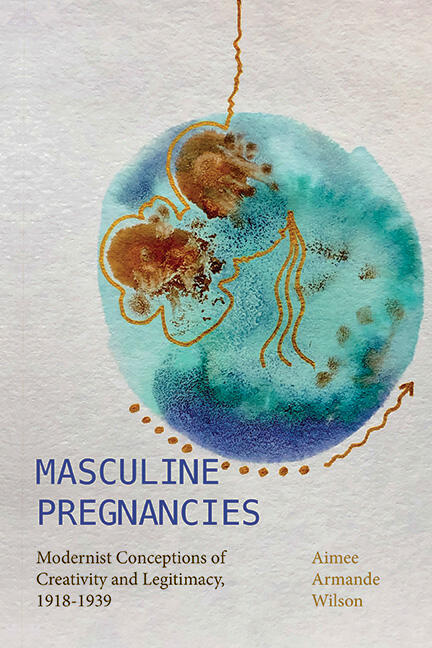'Masculine Pregnancies' reveals literary relationship between artistic creation and procreation

LAWRENCE — Pregnancy has traditionally been seen as among the most “feminine” traits.
A new book argues that not only is this perspective changing, but it’s also been a contested viewpoint in literature for more than a century.

“There are a lot of people who tend to think about pregnancy as being automatically connected to women and femininity,” said Aimee Wilson, associate professor of women, gender & sexuality studies at the University of Kansas.
“I’m making the argument that pregnancy and femininity — or pregnancy and womanhood — are not dependent on one another. In the early 20th century, writers adapted centuries-old reproductive themes by depicting queer pregnancy.”
Her latest book, “Masculine Pregnancies: Modernist Conceptions of Creativity and Legitimacy, 1918-1939,” reveals how modernist writers used depictions of “mannish” pregnant women and metaphors of male pregnancy to explore the relationship between artistic creation and physical procreation. It’s published by State University of New York Press.
Wilson said that when she discusses the concept of masculine pregnancy, she is referring to an umbrella term that she coined to cover a variety of ways that masculinity and pregnancy link in the imagination and reality. It includes topics that have been part of the scholarly conversation for a long time, like male characters who are pregnant in works of fiction, as well as ones that haven’t been studied by scholars before, like pregnant "mannish" women.

“Scholars typically argue that masculinity and pregnancy only combine in ways that are oppressive to women — like when male authors compare writing a book to having a baby and imply that male ‘procreation’ of this kind is superior,” she said. “By creating mannish female characters who are pregnant, modernist authors show us that masculinity and pregnancy can sometimes combine in ways that are liberating for women and queer people.”
The professor said one of her motivations for examining this subject is the current boom in “queer pregnancy literature.”
“Yet when people talk about these memoirs and novels in the popular press, they usually perceive it as something that doesn’t have a history,” she said. “One of the things my book does is demonstrate we have a long lineage of queer pregnancy in literature. It stretches back at least a century, and I would venture to guess further.”
In addition to works by William Faulkner and Ezra Pound, she cited Willa Cather’s 1918 novel “My Ántonia” as particularly notable. Wilson recalled reading the classic in high school.
“Honestly, I thought of it as a boring book about life on the prairie,” she said of the Nebraska-based tale concerning immigrants and the great migration.
“But when I returned to it, I found it queer in ways I hadn’t realized. The character Ántonia, when she’s a teenager working on the farm, says, ‘I like to be like a man.’ And when people complain she shouldn’t behave so mannishly, she says she prefers acting that way.”
When Ántonia is expecting, she still retains her masculine traits. By the end of the novel, she’s given birth to 10 children.
“I realized there was something really fascinating going on with the way Cather is depicting a woman as queer and pregnant, yet also depicting her as a domestic goddess. I’m interested in this idea that a masculine pregnant woman could be a figure of normativity and stability,” she said, noting that Cather herself wore men’s clothing and went by the name Will or Willie at various points in her life.
Mannishness was a concept (and term) popularized in the interwar years. Wilson explains societal fears arose that women were becoming too masculine because they had gone out and gotten jobs in factories.
“They were wearing pants, going to college and fighting for the right to vote. There was worry women were becoming problematically masculine. And there was also a lot of literary talk about pregnancy at this time. So I became interested in where these areas of discourse intersect,” she said.
In the years between the world wars, a perceived overlap between mannishness and lesbianism began surfacing, Wilson said.
She said, “These things weren’t always connected in the American worldview. Over the course of the 20th century, they increasingly became aligned to where there was an assumption that if you’re mannish then you must be sexually attracted to women as well.”
A KU faculty member since 2016, Wilson specializes in modernist literature, gender studies and feminist theory. Her first book, “Conceived in Modernism: The Aesthetics and Politics of Birth Control” (Bloomsbury, 2016), looks at the early birth control movement in the interwar years and how it overlaps with literature.
Wilson said she hoped her latest endeavor could change some long-standing viewpoints regarding the gender spectrum.
“We need to really push the conversation in a direction that is recognizing the legitimacy of queer people, including trans men, as reproducers in our society,” she said. “Literature can help us think through the ethical implications of our society’s approach to queer pregnancy.”
Top photo: iStock